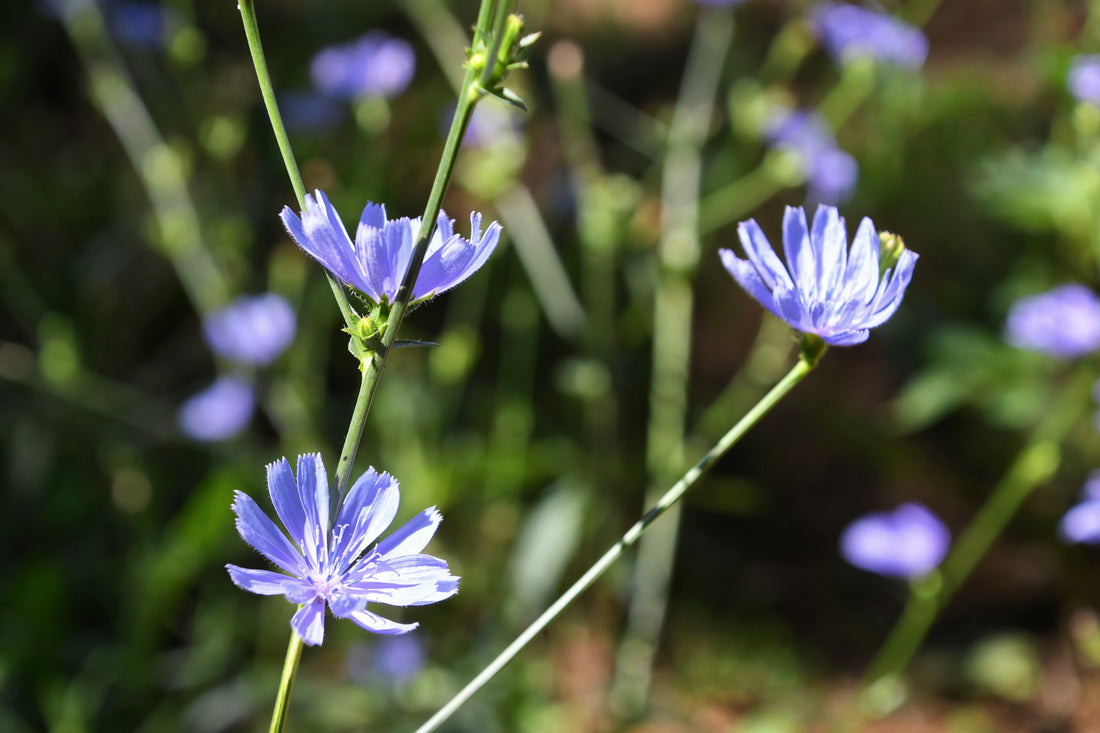
The Sky-Blue Survivor: Foraging Wild Chicory in Canada
Share
The Sky-Blue Survivor: Foraging Wild Chicory in Canada
Look along Canadian roadside verges, abandoned fields, or sunny, disturbed areas from summer into early fall, and you’ll likely spot a burst of stunning, sky-blue flowers seemingly defying the green and gold landscape. This resilient beauty is wild chicory (Cichorium intybus), a fascinating introduced plant with deep roots (literally and figuratively!) in history, ecology, and the forager's pantry.
Harvest with Honor: Our Wildcrafting Pledge
- Identify Beyond Doubt: Never consume unidentified plants.
- Take Only Needs: Harvest ≤10% of any patch; leave roots/crowns to regenerate.
- Pollinators First: Never compromise chicory's vital role as bee/butterfly food.
- Land Respect: Seek permission; avoid protected/polluted areas; leave no trace.
- Gratitude & Stewardship: Honor the land; replant seeds; share knowledge responsibly.
What Is Chicory?
Chicory is a hardy, herbaceous perennial, easily recognizable by its distinctive features:
- Flowers: Its most striking characteristic. Vibrant, daisy-like, sky-blue (rarely pink or white) flowers, typically 2-4 cm wide, bloom directly along stiff, branching stems. Crucially, they open in the morning sun and close by afternoon, acting as a natural clock.
- Leaves: Form a basal rosette close to the ground, resembling dandelion leaves but generally stiffer, more deeply toothed (pinnatifid), and often with a distinct reddish midrib. Smaller, clasping leaves grow sparsely up the stem.
- Stem: Tough, grooved, hairy, and branching, growing anywhere from 30 cm to over 1.5 meters tall.
- Root: A long, thick, dark brown taproot – the source of its most famous use.
What Does Chicory Do? Friend or Foe?
Chicory arrived in North America centuries ago from Europe, likely as a cultivated plant for food and medicine. It readily escaped and naturalized across Canada. So, is it helpful or harmful?
- Ecological Role: Chicory is generally considered beneficial or neutral within most Canadian ecosystems. It's not typically an aggressive invasive that crowds out native species in undisturbed habitats. Instead, it thrives in disturbed, "waste" areas.
- Pollinator Powerhouse: This is its superpower! Chicory flowers are a vital late-summer nectar and pollen source for a wide array of pollinators, especially bees (including honeybees and native species), butterflies, and hoverflies. When other blooms fade, chicory provides crucial sustenance.
- Soil Health: Its deep taproot helps break up compacted soil and can bring nutrients up from deeper layers.
- Livestock Forage: Chicory is increasingly planted intentionally as a high-protein, mineral-rich forage crop for livestock.
In short: While not native, wild chicory in Canada is primarily an ecological asset, especially for pollinators, rather than a significant problem plant. Its presence signals disturbed ground but brings beauty and vital food for insects.
A Taste of Tradition: Chicory Through Time
Humans have utilized chicory for millennia:
- Coffee Substitute/Enhancer: The most famous use! During historical coffee shortages (like the Civil War or WWII) and beyond, roasted and ground chicory root has been used as a caffeine-free coffee substitute or blended with coffee to add bitterness, depth, and body (think New Orleans-style coffee).
- Greens: Young basal leaves, especially before flowering or after the first frosts mellow their bitterness, have been eaten raw in salads or cooked as a potherb (like spinach or dandelion greens) across Europe and Asia.
- Medicinal: Traditionally, chicory root and leaves were used in herbal medicine for liver support, digestive complaints, and as a mild diuretic. The bitter compounds (like lactucin and intybin) are thought to stimulate digestion.
- Livestock Fodder: As mentioned, it's long been valued as animal feed.
The Canadian Forager's Guide to Chicory
Ethical Harvesting Reminder First: Chicory is an important pollinator resource. Never harvest all the flowers in an area, and always leave the majority blooming. Focus your harvest on roots and leaves, ensuring the plant population remains healthy and continues to feed bees and butterflies.
Sustainable Harvesting:
- Location: Choose abundant patches away from roadsides (pollution, spraying), industrial areas, dog walking paths, and protected lands. Seek permission for private land.
- Target Plants: Harvest from large, healthy patches. Never take more than 1/3 of the plants in any given area.
- Roots (Best in Fall or Early Spring):
- Target mature plants (2nd year+).
- Use a sturdy digging fork or hori hori knife to carefully loosen the soil deep and wide around the plant.
- Gently pull and wiggle to extract the long taproot intact. Avoid breaking it.
- Leave the crown and some root fragments behind! Chicory readily regenerates from root pieces. This ensures the patch persists.
- Re-fill the hole.
- Leaves (Spring & Fall are Best):
- Harvest only a few young, tender leaves from the outer part of the basal rosette per plant, leaving the center intact to grow.
- Avoid harvesting leaves from plants you are also digging for roots.
- Spring leaves are mildest; fall leaves reappear after flowering and are often sweeter after frost.
- Flowers (Use Sparingly!):
- Harvest minimally and ethically. Take only a flower or two per plant, only from very abundant patches, and always leave the vast majority for pollinators.
- Pick fully open flowers in the morning.
Preservation & Use:
- Roots:
- Cleaning: Scrub thoroughly with a brush. Chop into small, uniform pieces (chunks or chips).
- Drying: Dehydrate chunks at low heat (around 50°C/120°F) until hard and snap-able. Store in airtight jars.
- Roasting: Spread dried chunks on a baking sheet. Roast in a 180-200°C (350-400°F) oven, stirring frequently, until dark brown, fragrant, and oily-looking (like coffee beans). Cool completely.
- Grinding: Grind roasted roots in a coffee grinder. Use as a caffeine-free coffee substitute or blend 1:3 or 1:4 (chicory:coffee) with regular coffee.
- Benefits: Rich in inulin (a prebiotic fiber), adds deep, earthy, bitter notes. Traditionally used for digestive health.
- Leaves:
- Fresh: Use young leaves raw in salads (bitterness pairs well with sweet dressings, fruits, nuts). Cook older leaves like spinach (sautéing, steaming, adding to soups/stews reduces bitterness).
- Blanching & Freezing: Blanch leaves briefly in boiling water, plunge into ice water, drain thoroughly, and freeze in portions.
- Benefits: Good source of vitamins A, C, K, and minerals like potassium and manganese. The bitterness stimulates digestion.
- Flowers (Use Sparingly!):
- Fresh: Use as a stunning edible garnish (salads, desserts). The petals add color but minimal flavor.
- Infused Vinegar: Pack clean, dry flowers into a jar, cover with mild vinegar (like white wine vinegar), seal, and infuse for 1-2 weeks. Strain. Creates a beautiful pinkish-purple vinegar with subtle floral notes.
- Benefits: Primarily aesthetic/novelty. Minimal nutritional contribution compared to roots/leaves.
Final Foraging Thoughts: Ethics & Enjoyment
Crucial Reminders Before You Go:
- Pollinators Come First: Chicory's vibrant blue flowers are not just pretty; they are a critical late-season lifeline for bees and butterflies. Never over-harvest flowers. Take only what you need for a garnish or infusion, and leave the overwhelming majority for the insects who depend on them. This is non-negotiable for sustainable foraging.
- Resilience isn't Invincibility: While chicory is tough, harvesting roots kills the individual plant. Always harvest roots sustainably (less than 1/3 of a patch, leaving root fragments/crowns), and focus on leaves where possible.
- Know Your Spot: Avoid polluted areas (roadsides, industrial zones). Be 100% certain of your identification before consuming any wild plant. If in doubt, don't eat it!
- Respect the Land: Follow local regulations regarding foraging. Tread lightly, fill in holes after digging roots, and never leave a trace.
Wild chicory is a gift – a beautiful, useful, and ecologically valuable plant woven into the Canadian landscape. By foraging with deep respect, knowledge, and a primary focus on preserving its vital role for pollinators, we can sustainably enjoy its unique flavors and traditions. So, keep an eye out for that flash of blue, appreciate its beauty and purpose, and if you choose to harvest, do so thoughtfully and sparingly. Happy (and ethical) foraging!

